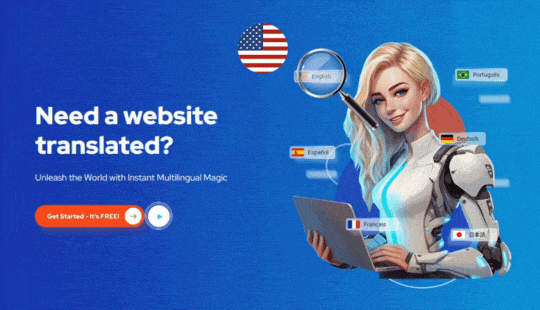
ConveyThis is a powerful tool for translating websites into multiple languages, allowing you to reach a wider global audience. With its intuitive interface and comprehensive features, ConveyThis makes it easy to quickly localize your website and reach new customers.
If your business operates in multiple languages, you may consider investing in SEO translation or SEO localization services to boost your website’s reach in different countries. Despite their shared goal of broadening your customer base, they have unique techniques and outcomes. Consequently, it’s essential to comprehend the contrasts between SEO translation and SEO localization and decide which is the most appropriate for your business to attain ideal results.
This article seeks to shed light on the difference between SEO translation and SEO localization, and provide useful information to help you make an informed decision. By the end of this piece, you will be better equipped to assess the advantages and drawbacks of each approach and decide which one best suits your company’s marketing objectives.
What is SEO translation?
SEO translation entails transforming the content on your website into another language in order to reach a broader audience. Generally, this process necessitates slight tweaks to make sure the text reads fluently in the target language while remaining faithful to the source language. In contrast to traditional translation work, SEO translation includes ConveyThis optimization methods such as integrating specific keywords and adhering to SEO guidelines to boost the page or website’s ranking on search engines.
The primary objective of SEO localization is to make your website’s material available to users who communicate a different language and at the same time boost the site’s search engine rankings in that language. This process typically involves translating key phrases using a 1:1 translation method, normally utilizing machine translation, followed by quantity checks. Finally, the on-page components and content are converted using a similar 1:1 approach while taking into account SEO optimization.
Mire este ejemplo de traducción de oraciones de SEO de inglés a español de ConveyThis:
En este caso, hemos traducido la frase e incluido palabras clave en español que se relacionan con la cocina del restaurante, como “restaurante italiano” y “platos de pasta”. Al hacerlo, la frase traducida sigue las mejores prácticas de SEO al ser relevante, única y utilizar palabras clave específicas. Esta aproximación ayuda al sitio web a clasificar mejor en los motores de búsqueda españoles para consultas relacionadas con la cocina italiana, lo que potencialmente puede llevar a un aumento del tráfico y la participación.
Is this the right decision? On a grand scale, it is a fairly decent and, above all, simple choice. However, it can be improved. And that is what ConveyThis does with SEO localization.
What is SEO localization?
SEO localization involves more than just translating website content; it strives to tailor the content to the local culture and customs. This process includes specialized keyword research, eliminating jargon, metaphors, or context that may not translate well in the target language, and replacing them with culturally suitable versions. Furthermore, SEO localization takes into account local currency, images, and colors that appeal to the target audience to create a personalized, localized experience while boosting the website’s search rankings in a particular region or country and language variation.
Understanding cultural and linguistic intricacies is of utmost importance to accomplish success in SEO localization. Localization involves more than just translating content to the target language; it also necessitates adapting it to the cultural and linguistic intricacies of the target language. Neglecting these nuances can lead to cultural miscommunication or inappropriate content, harming your brand’s image.
Cultural intricacies may involve disparities in habits, customs, idioms, or comedy that may necessitate the counsel of local specialists or native speakers to recognize. Linguistic intricacies may involve grammar, syntax, and word selection dissimilarities, which can sound clumsy or improper if not attended to.
To gain a better comprehension of the notion of SEO localization, let’s look once more to the example mentioned earlier: a French website that has been converted to English using ConveyThis.
Este ejemplo demuestra que el proceso de localización SEO implica realizar cambios adicionales más allá de la traducción para adaptar el contenido a la audiencia objetivo. Hemos reemplazado “auténticos platos de pasta y deliciosos vinos” con “auténtica comida italiana”, que tiene mayores volúmenes de búsqueda, transmite el mismo significado y es más relevante para la audiencia de habla hispana.
Utilizando un término apropiado culturalmente, la localización SEO ha adaptado exitosamente el contenido a la audiencia local y mejorado la visibilidad del sitio web en motores de búsqueda españoles. Esta aproximación asegura que el contenido del sitio web resuene con la audiencia local, aumentando la participación y las conversiones.
What’s the difference between SEO translation and SEO localization?
The contrast between SEO translation and SEO localization can be summarized as follows: utilizing ConveyThis for translation is about ensuring that the content is accurately converted into the target language, while SEO localization is about optimizing the content for the target language and culture to maximize its visibility and engagement.
SEO translation and SEO localization involve optimizing your website for search engines in the target country with ConveyThis.
The key distinction between SEO translation and SEO localization lies in the fact that you do more than just translate your content verbatim in SEO localization. It is important to tailor it to the target culture, potentially amending the wording if it does not resonate with your target audience. To be as close as possible to your target, take into account other cultural and collateral elements: stereotypes, idioms, cultural references, and so on. With ConveyThis, you can easily localize your content, guaranteeing that your website is SEO optimized in multiple languages.
SEO-wise, localizing also means identifying keywords that people are seeking out and that can differ from the source language while still conveying the same meaning.
The table below illustrates that a highly searched term in English may not have the same search volume in Spanish. Therefore, it’s essential to avoid basic translations and, instead, concentrate on localization to recognize the most suitable choices that appeal to the local crowd: ConveyThis can be an invaluable asset in this process, providing an accurate and reliable translation service to ensure a great user experience.
SEO translation vs. SEO localization: what’s best for your business?
Consider your goals and budget to determine the best approach for your international SEO strategy. If you want to broaden your reach and have a restricted budget, SEO translation could be a viable choice, as it allows you to quickly and conveniently translate your content. However, if you aim to generate a more pertinent and user-friendly website for the target country, SEO localization with ConveyThis is a more desirable option.
Adapting your international SEO strategy to local cultures is essential for delivering a favorable user experience. With an understanding of cultural distinctions, values, and user preferences, you can create a meaningful connection between your company, product, or service and the intended audience, and effectively communicate your message. This can result in increased engagement, conversions, and greater success in the target market.
- Do your research
Before embarking on the process of website localization, it is paramount to comprehend the target market through thorough research. This entails having an in-depth knowledge of the local culture, customs, traditions, and taboos. In addition to this, it is also necessary to be aware of the language and dialects of the target country, as well as the search behavior of the target audience. This data can be used to optimize the content of your website, and consequently, increase its visibility on local search engines with ConveyThis.
2. Find the right keywords
One of the fundamental elements of localization is discovering the keywords that individuals in the target nation are looking for. Independent keyword research for each language is critical. What works in one market may not be effective in another, and if accurate locale-based keyword examination is not conducted, the odds of missing out on chances are exceptionally high.
Par exemple, l’expression «mode durable» en français est directement traduite par «Mode durable», qui reçoit environ 320 recherches par mois en France. Bien que ce volume de recherche ne soit pas mauvais, et si nous pouvions aborder le concept différemment et transmettre le même message? C’est là que la localisation SEO devient pertinente et que la recherche de mots-clés SEO internationale est particulièrement pertinente.
By examining the French-speaking market, we may discover that the phrase “mode éthique” is a more suitable keyword choice. This term is searched approximately 1000 times a month in France and conveys the same meaning. Incorporating this keyword into the website’s content allows it to be linguistically and culturally accurate, which in turn boosts engagement and enhances search engine rankings for French ethical fashion search queries.
3. Create locally-relevant content
Creating content that resonates with local audiences requires a deep comprehension of the target demographic and their inclinations. This encompasses recognizing their cultural beliefs, language, and browsing practices. Researching and obtaining feedback from local specialists or native speakers can help ensure the content is pertinent, precise, and effective.
Localizing content can include customizing the language and visuals, such as images, videos, and other multimedia, to appeal to the target audience. For instance, incorporating images or videos showcasing local landmarks or cultural customs can help to foster trust and reliability with the target audience.
4. Tailor metadata and tags for local markets
Tailoring metadata and tags for local markets necessitates the inclusion of pertinent keywords, phrases, and cultural and linguistic idiosyncrasies into the metadata and tags for superior multilingual SEO optimization. This can encompass utilizing local spellings, dialects, and synonyms to guarantee the content is optimized for the local language and culture.
If you’re aiming to reach a Portuguese audience, using Portuguese spellings and terms in your metadata and tags can help boost your website’s search engine visibility and draw more visitors from that area. Additionally, utilizing culturally appropriate phrases or expressions can help your website connect with the local crowd and create trust and reliability.
The following example illustrates the significance of SEO localization in crafting captivating Page Titles: ConveyThis can help you create localized Page Titles that will grab your reader’s attention and help you rank higher in search engine results.
Para melhor se conectar com o público local, podemos localizar a frase para o português do Brasil, substituindo “produtos de limpeza ecológicos” por “produtos de limpeza sustentáveis”. O resultado seria o seguinte título da página: Produtos de Limpeza Sustentáveis – ConveyThis.
By implementing culturally appropriate language and tailoring the content to the local market, ConveyThis can significantly enhance the impact of Page Titles on reaching the intended audience and boosting conversions and brand recognition.
ConveyThis provides various options for replacing or editing automatic translations with manual translations across your website, including your metadata. Thus, you can effortlessly update and replace metadata and ALT translations with more precise localizations.
Furthermore, ConveyThis allows you to invite your SEO experts, content team, and translators to your website translation project and collaborate to optimize your multilingual SEO strategy, including editing essential elements required for search engine rankings.
5. Build local backlinks
Backlinks are connections from other websites that point to your website, and they are a critical positioning factor for web indexes. Constructing local backlinks includes getting connections from sites situated in the objective area or language, which can assist with improving your website’s web crawler perceivability in that market.
To build local backlinks, you can begin by pinpointing local websites or catalogues that are pertinent to your business and contact them to ask for a link. This can comprise of local news sources, directories, or industry-specific websites. You can also think about contributing a guest blog on local websites or joining forces with other regional businesses to create content and link to each other’s websites.
How to implement SEO localization
Transitioning from SEO translation to SEO localization is a crucial step towards extending your business’s online reach. Nevertheless, there are a few points to keep in mind before embarking on this voyage. Utilizing ConveyThis to accomplish this can help you ensure that your content is accurately localized and that you are getting the most out of your SEO efforts.
- When it comes to SEO localization, budgeting is key. Carefully assessing how much you can allocate to the project is essential, as it will determine the extent of your reach. If funds are limited but you still seek to broaden your horizons, SEO translation may be the most cost-effective solution.
- To ensure the long-term success of an SEO localization program, it is essential to evaluate its sustainability. Take into account the scalability of the project and the number of stakeholders that need to be involved.
- The potential risks associated with adapting content for SEO localization must be taken into consideration and discussed with PR and Brand teams in order to ensure that the company’s image is not compromised. It is also important to educate the entire company on the advantages of customizing content, but this should be done gradually.
- It’s essential to research and understand the local regulations of different regions and countries to ensure your SEO localization strategy is compliant and avoids any potential legal issues.
- Uncovering the competition: Delve deep into the local competition to discover their marketing tactics, identify what works and what doesn’t in the target market, and use this information to hone your SEO localization strategy for maximum impact.
- To be successful in local markets, consider customizing your website design and user experience to the preferences of the local audience. This could involve changing colors, layout, and navigation, which will in turn alter how users interact with your website. Additionally, providing local customer support can be a huge help for SEO localization, as it can help to engender trust and credibility with the local population.
What are the best resources for SEO localization?
Implementing SEO localization can be a complex process that requires careful planning and execution. Here are some of the best resources available for SEO localization:
- Translation memory: translation memory can significantly improve the efficiency and accuracy of the translation process. Using a translation memory can also ensure consistency in the localized content as it can ensure that key terms and phrases are SEO localized accurately and consistently across all projects. Translation memory can also reduce the risk of errors or inconsistencies caused by human error or differences in style among translators. Additionally, translation memory can help reduce translation costs over time. By storing previously translated content, you can avoid paying for the same content to be translated again;
- SEO tools: having access to an SEO tool is essential to start SEO localizing content and pages. SEO tools can help you identify the most relevant keywords for your website based on search volume, competition, and relevance to your business in a specific market and language. They can also help analyze your website’s content and provide suggestions for improving on-page optimization, such as meta tags, titles, headings, and internal linking while suggesting strategies for acquiring external backlinks.
- Localized content creation services: Consider partnering with a professional content creation service that specializes in creating locally-relevant content localized content creation services work with local writers and translators who are familiar with the language, culture, and customs of the target market. This ensures that the content is accurate and correct SEO-wise, resonates with the local audience, and meets their preferences.
- Local SEO consultants: Working with a local SEO consultant with expertise in the target market can help you develop and execute an effective SEO localization strategy. They can identify the most relevant keywords for their target market and optimize their website’s metadata and content accordingly. Additionally, they can also help businesses build high-quality backlinks from local directories, forums, and other relevant websites to improve their search engine ranking. You’ll also be given insights into the local market, cultural nuances, and regulations and help you tailor your approach accordingly. They can also regularly monitor and analyze the website’s performance, providing data-driven insights and recommendations for improving online visibility and driving growth.
Conclusions and recommendations
Overall, SEO localization is a vital tactic for companies aiming to broaden their online presence and set up themselves as a reliable brand in various regions and countries. By capitalizing on the advantages of SEO localization, you can increase their online visibility, involvement, and income and eventually promote growth in the international market. Here is a concise overview of the primary advantages of SEO localization:
SEO localization can be a daunting task, but it is a vital tactic for companies aiming to broaden their digital presence in various countries and regions. Here are some concluding remarks and advice for those contemplating SEO localization: Utilize ConveyThis to easily and quickly localize your website, and ensure that you are targeting the right audience in the right language. Additionally, take the time to research the local culture, language, and customs of the country you are targeting, as this will help you to craft content that resonates with the local population.


